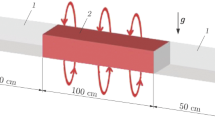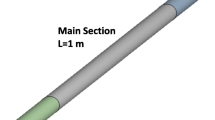Abstract
Turbulent heat transfer, pressure drop and wall shear stress behavior of the nanofluid Al2O3-water mixture in a square duct under constant wall heat flux are investigated numerically. Single-phase approach is taken into account during the simulations. All of the nanofluid properties depend on the temperature and the nanoparticle volume concentration. The renormalization group theory RNG \({k-\varepsilon}\) model is employed in order to model turbulence. Validation tests of the numerical results are done by using water as the first working fluid. Similar models and methods are chosen for the simulation of nanofluid (Al2O3-water) flow and heat transfer. A very good agreement is realized with the previous water and nanofluid related theoretical-empirical heat transfer and pressure drop correlations. The rate of heat transfer is increased by the presence of nanofluids when compared to that of water. Increasing Re number and particle’s volumetric concentration increases the convection heat transfer coefficient, pressure drop and wall shear stress along the duct. On the other hand, this study confirmed that single-phase model approach is appropriate for the simulation of Al2O3-water flow and heat transfer.
Similar content being viewed by others
Abbreviations
- a P :
-
Coefficient of P cell
- \({{C}_{1\varepsilon}}\) :
-
Turbulent model constant (= 1.42)
- \({{C}_{2\varepsilon}}\) :
-
Turbulent model constant (= 1.68)
- C p :
-
Constant pressure specific heat (J/kgK)
- \({{C}_{\mu}}\) :
-
Turbulent model constant (= 0.0845)
- c :
-
Constant part of the source term
- D :
-
Hydraulic diameter (m)
- f :
-
Darcy friction factor
- g :
-
Gravitational acceleration (m/s2)
- h :
-
Convection heat transfer coefficient (W/m2K)
- I :
-
Turbulent intensity \({({=}{u}'/\overline u)}\)
- k :
-
Turbulent kinetic energy (m2/s)
- L :
-
Length of the duct (m)
- l :
-
Turbulent mixing length (m)
- \({{l}_{\varepsilon}}\) :
-
Length scale of turbulent kinetic energy dissipation (m)
- \({{l}_{\mu}}\) :
-
Length scale of viscosity (m)
- Nu :
-
Nusselt number
- P :
-
Pressure (Pa)
- Pr :
-
Prandtl number
- \({q^{\prime\prime}}\) :
-
Wall heat flux (W/m2)
- \({R^\prime}\) :
-
Effect of strain in \({\varepsilon}\) equation (kg/ms4)
- Re :
-
Re number
- S :
-
Modulus of mean rate of strain tensor (1/s)
- T :
-
Temperature (K)
- \({{\overline{u}}}\) :
-
Time-averaged mean velocity (m/s)
- \({u^\prime}\) :
-
Instantaneous velocity component (m/s)
- u :
-
Velocity (m/s)
- t :
-
Time (s)
- u :
-
Velocity (m/s)
- X :
-
Distance from the entrance of the duct (m)
- \({y^{\ast}}\) :
-
Non-dimensional viscous sublayer thickness
- \({y_{T}^\ast}\) :
-
Non-dimensional thermal sublayer thickness
- \({\alpha}\) :
-
Inverse effective Pr number (= 1/Pr)
- \({\alpha_{\varepsilon}}\) :
-
Inverse effective Pr number for dissipation rate of turbulent kinetic energy (= 1/\({{\rm Pr}_{\varepsilon}}\))
- \({\alpha_{k}}\) :
-
Inverse effective Pr number for turbulent kinetic energy (= 1/Pr k )
- \({\alpha_{t}}\) :
-
Inverse effective Pr number for turbulent flow (= 1/Pr t )
- \({\beta}\) :
-
Model constant (= 0.012)
- \({\Delta {P}}\) :
-
Pressure drop (Pa)
- \({\varepsilon}\) :
-
Turbulent kinetic energy dissipation rate (m2/s3)
- \({\eta}\) :
-
Rate of strain in turbulent flow (\({={\rm Sk}/\varepsilon)}\)
- \({\tau}\) :
-
Wall shear stress (N/m2)
- \({\eta_{0}}\) :
-
Model constant (= 4.38)
- \({\lambda}\) :
-
Thermal conductivity (W/mK)
- \({\mu}\) :
-
Molecular viscosity (kg/ms)
- \({\phi}\) :
-
Volumetric concentration of nanoparticles
- \({\rho}\) :
-
Density (kg/m3)
- bf :
-
Base fluid
- eff :
-
Effective
- l :
-
Laminar
- nb :
-
Neighbor cell
- nf :
-
Nanofluid
- np :
-
Nanoparticle
- P :
-
P center cell
- t :
-
Turbulent
- w :
-
Wall
References
Pak B.C., Cho Y.I.: Hydrodynamic and heat transfer study of dispersed fluids with submicron metallic oxide particles. Exp. Heat Transf. 11, 151–170 (1998)
Kays, W.M.; Crawford, M.E.: Convective Heat andMass Transfer, 3d edn. pp. 244–249. McGraw-Hill, New York (1993)
Heyhat M.M., Kowsary F., Rashidi A.M., Esfehani S.A.V., Amrollahi A.: Experimental investigation of turbulent flow and convective heat transfer characteristics of alumina water nanofluids in fully developed flow regime. Int. Commun. Heat Mass Transf. 39, 1272–1278 (2012)
Sahin B., Gültekin G.G., Manay E., Karagöz S.: Experimental investigation of heat transfer and pressure drop characteristics of Al2O3-water nanofluid. Exp. Therm. Fluid Sci. 50, 21–28 (2013)
Hussein, A.; Sharma, K.V.; Bakar, R.A.; Kadirgama, K.: The effect of nanofluid volume concentration on heat transfer and friction factor inside a horizontal tube. J. Nanomater. 2013, Article ID 859563 (2013). http://dx.doi.org/10.1155/2013/859563
Maiga S.B., Nguyen C.T., Galanis N., Roy G., Mare T., Coqueux M.: Heat transfer enhancement in turbulent tube flow using Al2O3 nanoparticle suspension. Int. J. Numer. Methods Heat Fluid Flow 16, 275–292 (2006)
Bayat J., Nikseresht A.H.: Thermal performance and pressure drop analysis of nanofluids in turbulent forced convective flows. Int. J. Therm. Sci. 60, 236–243 (2012)
Bianco V., Manca O., Nardini S.: Numerical investigation on nanofluids turbulent convection heat transfer inside a circular tube. Int. J. Therm. Sci. 50, 341–349 (2011)
Heris S.Z., Nassan T.H., Noie S.H., Sardarabadi H., Sardarabadi M.: Laminar convective heat transfer of Al2O3/water nanofluid through square cross-sectional duct. Int. J. Heat Fluid Flow 44, 375–382 (2013)
Heris S.Z., Kazemi B., Noie S.H., Rezvan S.: Numerical study on convective heat transfer of Al2O3/Water, CuO/Water and Cu/Water nanofluids through square cross-section duct in laminar flow. Eng. Appl. Comput. Fluid Mech. 6, 1–14 (2012)
Bianco V., Nardini S., Manca O.: Enhancement of heat transfer and entropy generation analysis of nanofluids turbulent convection flow in square section tubes. Nanoscale Res. Lett. 6, 1–12 (2011)
Sahin A.Z.: Irreversibilities in various duct geometries with constant wall heat flux and laminar flow. Energy 23(6), 465–473 (1998)
Kaya O.: Numerical study of turbulent flow and heat transfer of Al2O3-water mixture in a square duct with uniform heat flux. Heat Mass Transf. 49, 1549–1563 (2013)
Xuan Y., Li Q.: Investigation on convective heat transfer and flow features of nanofluids. J. Heat Transf. 125, 151–155 (2003)
Nguyen, C.T.; Roy, G.; Lajoie, P.R.: Refroidissement des microprocesseurs a haute performance en utilisant des nano fluides. Congres Français de Thermique, SFT, Reims, 30 mai-2 juin 2005 (2005)
Luciu, R.S.; Mateescu, T.; Cotorobai, V.; Mare, T.: Nusselt number and convection heat transfer coefficient for a coaxial heat exchanger using Al2O3-Water pH = 5 nanofluid, Buletinul Inst. Polit Iaşi, t.LV (LIX), f.2 71–80 (2009)
Fluent User’s Guide: Fluent Incorporated Centerra Resource Park, Lebanon (1998)
Dittus F.W., Boelter L.M.K.: Heat transfer for automobile radiators of the tubular type. Univ. Calif. Publ. Eng. 11, 443–461 (1930)
Gnielinski V.: New equations for heat and mass transfer in turbulent pipe and channel flow. Int. Chem. Eng 16, 359–368 (1976)
Notter R.H., Rouse M.W.: A solution to the turbulent Graetz problem, III. Fully developed region heat transfer rates. Chem. Eng. Sci. 27, 2073–2093 (1972)
Petukhov, B.S.: Heat Transfer and Friction in Turbulent Pipe Flow with Variable Physical Properties, Advances in Heat Transfer, vol. 6. pp. 504–564. Academic Press. Inc, New York (1970)
Blasius H.: Grenzschichten in Flussigkeiten mit kleiner reibung (German). Z. Math. Phys. 56, 1–37 (1908)
Author information
Authors and Affiliations
Corresponding author
Rights and permissions
About this article
Cite this article
Kaya, O. Numerical Investigation of Heat Transfer, Pressure Drop and Wall Shear Stress Characteristics of Al2O3-Water Nanofluid in a Square Duct. Arab J Sci Eng 40, 3641–3655 (2015). https://doi.org/10.1007/s13369-015-1790-y
Received:
Accepted:
Published:
Issue Date:
DOI: https://doi.org/10.1007/s13369-015-1790-y




